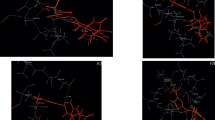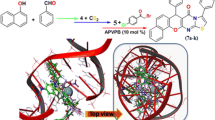Abstract
A new compound 4-[2-allylsulfanyl-1-(carboxymethyl-carbamoyl)-ethylcarbamoyl]-2-amino-butyric acid (ASAB) bearing allyl group was synthesized and characterized by spectroscopic (FTIR, NMR, & LC–MS) methods. ASAB showed significant antibacterial activity against gram-positive (S. aureus) and gram-negative (E. coli) bacteria. ASAB was screened for interaction with type I and II DNA topoisomerase activity via in vitro supercoil relaxation assay. ASAB was found to be a strong inhibitor for topoisomerases; with much more significant inhibition for topoisomerase II than topoisomerase I. Furthermore, DNA binding properties of ASAB with pBR322 DNA was investigated by fluorescent spectra which revealed its DNA binding ability. Molecular docking study was performed to elucidate the specific binding site in the active site of topoisomerase I & II.






Similar content being viewed by others
References
Arjmand F, Parveen S, Afzal M, Shahid M (2012) Synthesis, characterization, biological studies (DNA binding, cleavage, antibacterial and topoisomerase (I) and molecular docking of copper(II) benzimidazole complexes. J Photochem Photobiol B 114:15–26
Champoux JJ (2001) DNA topoisomerases: structure, function and mechanism. Annu Rev Biochem 70:369–413
Cho HJ, Jung MJ, Kwon Y, Na Y (2009) Oxiranylmethyloxy or thiiranylmethyloxy-azaxanthones and –acridone analogues as potential topoisomerase I inhibitors. Bioorg Med Chem 19:6766–6769
Chowdhury AR, Sharma S, Mandal S, Goswami A, Mukhopadhyay S, Majumder HK (2002) Luteolin an emerging anticancer flavonoid poisons eukaryotic DNA topoisomerase I. Biochem J 366:653–661
Chu Q, Ling MT, Feng H, Cheung HW, Tsao SW, Wang X, Wong YC (2006) A novel anticancer effect of garlic derivatives: inhibition of cancer cell invasion through restoration of E-cadherin expression. Carcinogenesis 27:2180–2189
Chu Q, Lee DT, Tsao SW, Wang X, Wong YC (2007) S-allylcysteine, a water-soluble garlic derivative, suppresses the growth of a human androgen-independent prostate cancer xenograft, CWR22R, under in vivo conditions. BJU Int 99:925–932
Eldridge MD, Murray CW, Auton TR, Paolini GV, Mee RP (1997) Empirical scoring functions: I. The development of a fast empirical scoring function to estimate the binding affinity of ligands in receptor complexes. J Comput-Aided Mol Des 11:425–445
Filomeni G, Rotilio G, Ciriolo MR (2008) Molecular transduction mechanisms of the redox network underlying the antiproliferative effects of allyl compounds from garlic, American Society for Nutrition. J Nutr 138:2053–2057
Fukuda M, Nishio K, Kanzawa F, Ogasawara H, Ishida T, Arioka H, Bonjanowski K, Oka M, Saijo N (1996) Synergism between cisplatin and topoisomerase I inhibitors, NB-506 and SN-38, in human small cell lung cancer cells. Cancer Res 56:789–793
Gapter LA, Yuin OZ, Ng KY (2008) S-Allylcysteine reduces breast tumor cell adhesion and invasion. Biochem Biophys Res Commun 367:446–451
Ishikawa H, Saeki T, Otani T, Suzuki T, Shimozuma K, Nishino H, Fukuda Se, Morimoto K (2006) Significance of garlic and its constituents in cancer and cardiovascular disease aged garlic extract prevents a decline of NK cell number and activity in patients with advanced cancer. J Nutr 136:816S–820S
Janovec L, Kozurkova M, Sabolova D, Ungvarsky J, Paulikova H, Plšikova J, Vantova Z, Imrich J (2011) Synthesis, DNA binding and molecular modeling. Bioorg Med Chem 19:1790–1801
Kang DH, Kim JS, Jung MJ, Lee ES, Jahng Y, Kwon Y, Na Y (2008) New insight for fluoroquinophenoxazine derivatives as possibly new potent topoisomerase I inhibitor. Bioorg Med Chem Lett 18:1520–1524
Lazaro ML, Cordero CM, Bermejo A, Cortes D, Ayuso MJ (2001) Cytotoxic compounds from Annonaceus species as DNA topoisomerase I poisons. Anticancer Res 21:3493–3497
McKenna DJ, Jones K, Hughes K, Humphrey S (2002) Botanical medicines, the desk references for major herbal supplements, 2nd edn. The Haworth Herbal Press, New York
Mundo NH, Adaya DS, Maldonado PD, Galván-Arzate S, Martinez LA, Cruz VPDL, Chaverri JP, Santamaria A (2006) S-allylcysteine prevents the rat from 3-nitropropionic acid-induced hyperactivity early markers of oxidative stress and mitochondrial dysfunction. Neurosci Res 56:39–44
Ng KTP, Guo DY, Cheng Q, Geng W, Ling CC, Li CX, Liu XB, Ma YY, Lo CM, Poon TP, Fan ST, Man K (2012) A garlic derivative, S-allylcysteine (SAC), suppresses proliferation and metastasis of hepatocellular carcinoma. PLoS One 7:1–9
Nishimura H, Mizutani J (1975) Photochemistry and radiation chemistry of sulfur-containing amino acids. New reaction of the 1-propenylthiyl radicals. J Org Chem 40:1567–1575
Nitiss JL (1998) Investigating the biological functions of DNA topoisomerases in eukaryotic cells. Biochim Biophys Acta 1400:63–81
Park K, Kim J, Lim S, Han S (2003) Topoisomerase II-α (topoII) and HER2 amplification in breast cancers and response to preoperative doxorubicin chemotherapy. Eur J Med Chem 39:631–634
Pommier Y, Leo E, Zhang H, Marchand C (2010) DNA topoisomerases and their poisoning by anticancer and antibacterial drugs. Chem Biol 17:421–433
Shahabadi N, Falsafi M, Moghadam NH (2013) DNA interaction studies of a novel Cu (II) complex as an intercalator containing curcumin and bathophenanthroline ligands. J Photochem Photobiol B 122:45–51
Tabassum S, Afzal M, Arjmand F (2012) New heterobimetallic CuII—Sn2 IV complex as potential topoisomerase I inhibitor: in vitro DNA binding, cleavage and cytotoxicity against human cancer cell lines. J Photochem Photobiol B 115:63–72
Tang FY, Chiang EP, Chung JG, Lee HZ, Hsu CY (2009) S-allylcysteine modulates the expression of E-cadherin and inhibits the malignant progression of human oral cancer. J Nutr Biochem 20:1013–1020
Tang FY, Chiang EP, Pai MH (2010) Consumption of S-allylcysteine inhibits the growth of human non-small-cell lung carcinoma in a mouse xenograft model. J Agric Food Chem 58:11156–11164
Threlfall EJ, Fisher IST, Ward L, Tschape H, Gernersmidt P (1999) Harmonization of antibiotic susceptibility testing for Salmonella Results of a study by 18 national reference laboratories within the European Union-funded Enter-Net group. Micro Drug Resist 5:195–199
Walker RD (2000) Antimicrobial susceptibility testing and interpretation of results. In: Prescott JF, Baggot JD, Walker RD (eds) Antimicrobial Therapy in Veterinary Medicine. Iowa State University Press, Ames, pp 12–26
Wang JC (1996) DNA topoisomerases. Annu Rev Biochem 65:635–692
Welch C, Wuarin L, Sidell N (1992) Antiproliferative effect of the garlic compound S-allyl cysteine on human neuroblastoma cells in vitro. Cancer Lett 63:211–219
Wu WB, Ou JB, Huang ZH, Chen SB, Ou TM, Tan JH, Li D, Shen LL, Huang SL, Gu LQ, Huang ZS (2011) Synthesis and evaluation of mansonone F derivatives as topoisomerase inhibitors. Eur J Med Chem 46:3339–3347
Author information
Authors and Affiliations
Corresponding author
Electronic supplementary material
Below is the link to the electronic supplementary material.
Rights and permissions
About this article
Cite this article
Pratheebaa, P., Perumal, P., Angayarkanni, J. et al. 4-[2-Allylsulfanyl-1-(carboxymethyl-carbamoyl)-ethylcarbamoyl]-2-amino-butyric acid: evaluation as topoisomerase inhibitor using in vitro assay and molecular docking study. Med Chem Res 24, 1893–1900 (2015). https://doi.org/10.1007/s00044-014-1263-y
Received:
Accepted:
Published:
Issue Date:
DOI: https://doi.org/10.1007/s00044-014-1263-y




